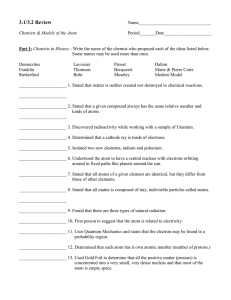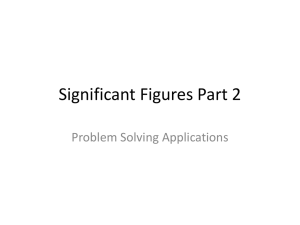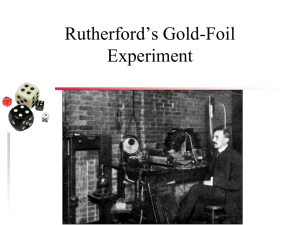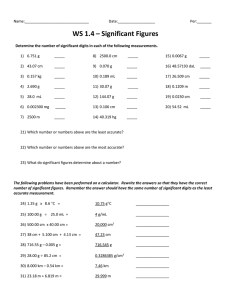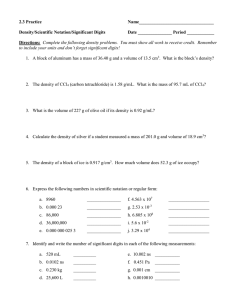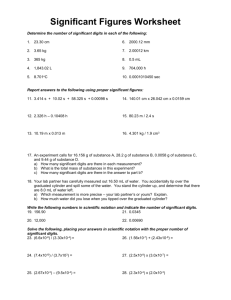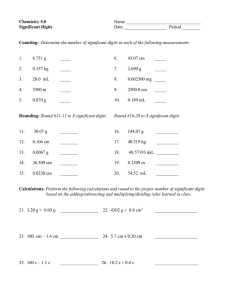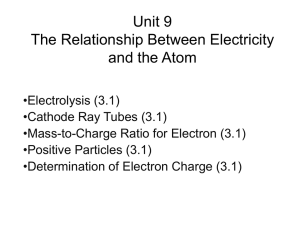CHAPTER 1, 2 and 3 CUMULATIVE REVIEW Name: __________________________ Period_________Date: ____________
advertisement
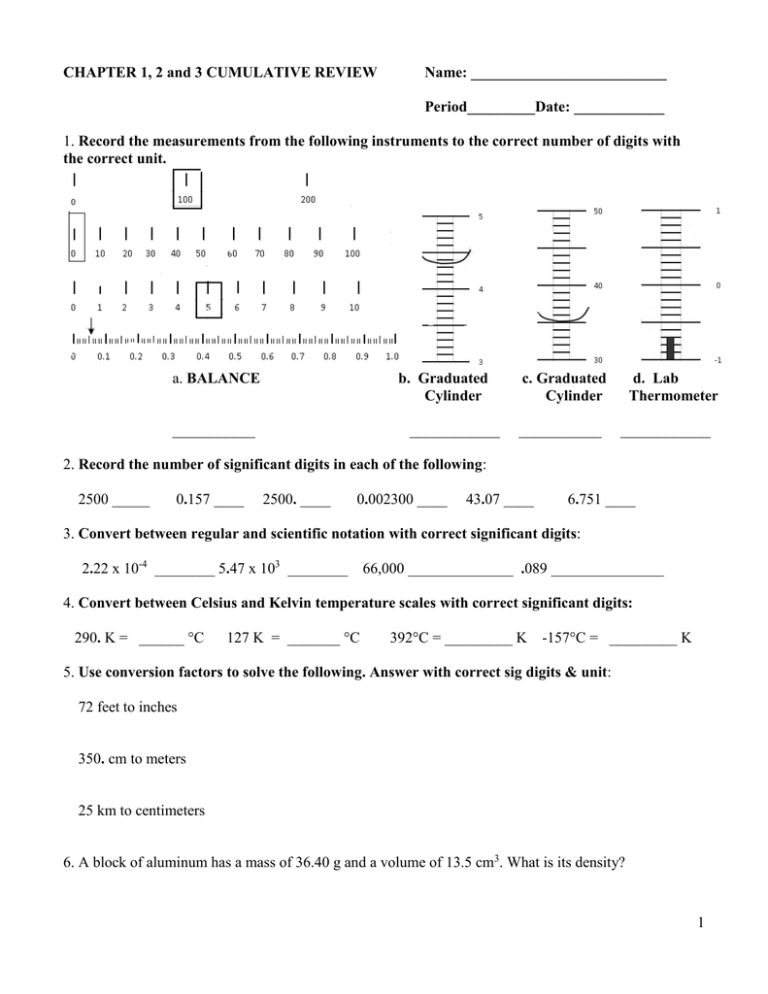
CHAPTER 1, 2 and 3 CUMULATIVE REVIEW Name: __________________________ Period_________Date: ____________ 1. Record the measurements from the following instruments to the correct number of digits with the correct unit. a. BALANCE b. Graduated Cylinder ___________ ____________ c. Graduated Cylinder ___________ d. Lab Thermometer ____________ 2. Record the number of significant digits in each of the following: 2500 _____ 0.157 ____ 2500. ____ 0.002300 ____ 43.07 ____ 6.751 ____ 3. Convert between regular and scientific notation with correct significant digits: 2.22 x 10-4 ________ 5.47 x 103 ________ 66,000 ______________ .089 _______________ 4. Convert between Celsius and Kelvin temperature scales with correct significant digits: 290. K = ______ °C 127 K = _______ °C 392°C = _________ K -157°C = _________ K 5. Use conversion factors to solve the following. Answer with correct sig digits & unit: 72 feet to inches 350. cm to meters 25 km to centimeters 6. A block of aluminum has a mass of 36.40 g and a volume of 13.5 cm3. What is its density? 1 7. What is the volume of 227 g of olive oil if its density is 0.92 g/mL. 8. Define accuracy _____________________________ & precision _______________________________. 9. MASS OF SAMPLE Team 1 Team 2 Team 3 Reading 1 41.04 g 31.33 g 42.34 g Reading 2 39.77 g 31.30 g 41.12 g Reading 3 43.15 g 31.36 g 41.21 g Average 41.32 g 31.33 g 41.55 g Accepted measure from issuing lab: 41.33 g Percent error 0.02% 24.2% 0.53% Which team is most accurate? _______ Least accurate? _______ Which team is most precise? _______ Least precise? _______ Which team has the best accuracy and precision? ________ 10. Label the phases, phase changes, and freezing/boiling temperatures on the heating/cooling curve for water. What is happening to kinetic energy during section A? _________ What is happening to kinetic energy during section E/F? ______________ 11. Pure substances are either __________________ or __________________. Mixtures may be either ________________________ or ____________________________. Three types of homogeneous mixtures are: _________________ (clear & uniform), __________________ (cloudy & uniform) and _________ (opaque, uniform blend of metals). At first glance a colloid & suspension may look similar. The difference is ___________________________________________________________________. 2 12. Classify the following as element (E), compound (C), solution (S), alloy (A), colloid (CL) or suspension (SP). ____ gold ____ water ____ brass ____ carbon ____ whipped cream ____ milk ____ salt & water ____ carbon dioxide ____ gold jewelry ____ sand & water 13. ______________ properties can be measured without changing the chemical composition of a substance. ______________ properties describe chemical reactions a substance will/will not undergo. 14. Classify the following as physical (P) or chemical (C) properties: ____color ____ tendency to rust ____ mass ____ boiling point ____ reactivity with oxygen ____ flammability ____ noble gases are inert ____ density 15. Physical changes change the ___________________, but not the chemical composition of a substance. Chemical changes (chemical reactions) create new _______________________. 16. Classify the following as physical (P) or chemical (C) changes: ____ melting iron ____ burning gasoline ____ breaking test tube ____ wood rotting ____ dissolving NaCl ____ reacting Mg w HCl ____ boiling water ____ iron rusting 17. What are the four signs of a chemical change? 18. A student experimentally determined the density of a piece of aluminum to be 2.95 g/cm3. The accepted value for aluminum density is 2.70 g/cm3. Calculate the student’s percent error. 19. How many seconds has a teenager been alive by their 17th birthday? Put your answer in scientific notation. 20. If you drive 1.08 x 106 cm from the high school to 309 Cinema, how many miles is it? (Given: 1 mile = 5280 ft and 2.54 cm = 1 in) 3 21. Isotope Name Symbol Atomic Number Mass Number Protons Neutrons Electrons potassium-38 Charge 0 65 29 Cu +2 20 22 78 51 35 +2 36 123 -3 22. In Thomson’s experiment, the cathode ray was deflected by a magnet, this indicated that the ray had ____________. When the electrically charged plates were turned on, the cathode ray was deflected toward the positive plate, this indicated that the beam had a ________________ charge. 23. Therefore a cathode ray is made of a beam of ____________________. 24. Rutherford used a radioactive sample and determined that natural radiation has ______ components: alpha particles which have a _______ charge and a relatively _______________ mass, ________________ particles which have a negative charge and a mass of ______ and ________________ rays which are neutral and have ________ mass. 25. Rutherford used alpha particles in his Gold Foil experiment. Because the alpha particles are relatively large and positive the fact that most of them proceeded straight through the foil proved that the atom is mostly _______________ ______________. Some of the positive alpha particles deflected directly back toward the source which indicated that the nucleus was __________________ charged Thus, Rutherford is credited with discovering the ________________. 26. Draw a simple sketch of each chemist’s model of the atom. Indicate charge where needed. Dalton Thomson Rutherford Bohr Modern Model 4
